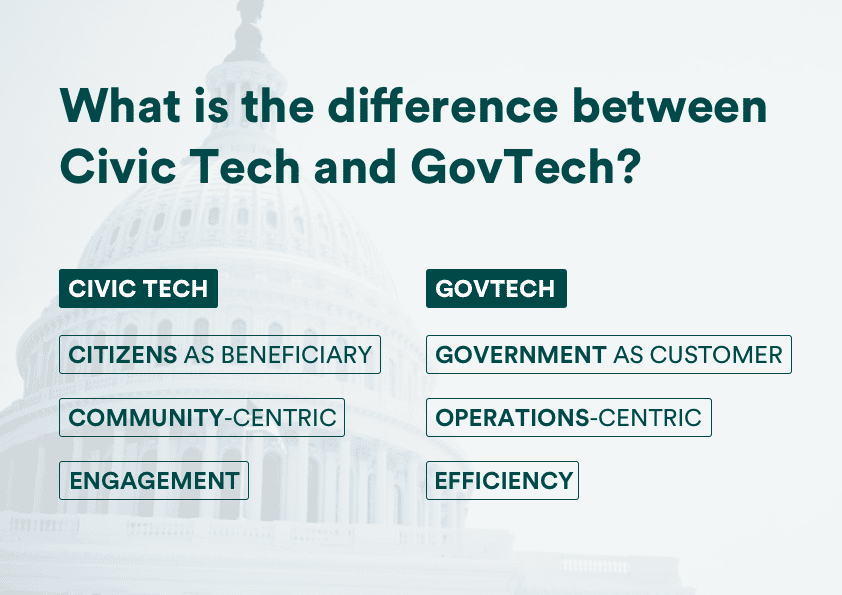This article was published on Apolitical. Find the original article here.
In recent years, “Civic Tech” and “GovTech” have become popular catch-phrases, often loosely used to describe innovations in the field of government and citizen participation. But are they really the same thing?
Despite sounding very similar Civic Tech and GovTech actually describe two very different concepts: they are used by different audiences, and serve very different purposes. What might seem like a small semantic difference is actually the reflection of a fundamental balance between two founding principles of democracy: legitimacy and efficiency.
“Civic Tech” was initially the predominant term. Google searches show that searches for “GovTech” were rather rare until late 2016, when they suddenly increased and overtook searches for Civic Tech. One of the possible reasons for this rise could be the launch of the Singapore GovTech team around that time, with public focus shifting from small, private sector innovation around Civic Tech to larger GovTech initiatives coming from states and cities.
Engagement vs efficiency
There are many subtle differences between Civic Tech and GovTech, but the main thing to remember is this: while GovTech includes a wide range of technologies provided to governments to increase the efficiency of their internal operations, Civic Tech focuses on informing citizens, connecting them with each other and getting them to engage with their government in order to work together for the public good.
Civic Tech focuses on citizens. Wikipedia defines the term as “a technology that enables engagement, participation or enhances the relationship between the people and government by enhancing citizen communications and public decision”. It aims to develop engagement and to encourage citizens to act for the public good.
Some Civic Tech tools are used by governments to get in touch with citizens, but some other tools are used independently of governments by civil society organisations or even independent citizens.
The benefits of Civic Tech are easy to see: by helping citizens connect to each other and speak with their government, it empowers citizens and fuels social change. It can also help governments get a better understanding of what their citizens want and need.
In GovTech, the primary beneficiaries are governments. The aim of GovTech aim is to increase efficiency in administration by digitalising work processes or bringing in new tools.
In a recent report, Deloitte estimated that introducing artificial intelligence in governments’ work processes could increase efficiency and free up to 30% of government workers’ time, saving up to $41,1 billion per year for governments worldwide. The time and money saved through this could then be invested in other areas, therefore ultimately benefiting citizens.
If, for instance, a city implements a new tool to process taxes more efficiently, citizens will see the benefits of the innovation through reduced waiting times or easier procedures. In the long term, increasing efficiency also means reducing costs, and the money spent processing taxes could then be spent on healthcare or education, therefore bringing benefits to citizens as a whole.
GovTech’s measures of success, on the other hand, are efficiency gains and costs saved.

Main challenges
In order to truly foster change, Civic Tech tools need to reach a large number of users; their main challenge is, therefore, to engage citizens on a large scale.
Most Civic Tech tools are free to use (for citizens at least), which also raises the question of sustainability. Companies providing Civic Tech tools have to work out business models without compromising the integrity of the tool and maintaining free access. Some tools like CitizenLabhave chosen to go for a licensing model, selling their platforms to cities and governments. Some others, like Neighborland, rely on consulting.
Platforms with large audiences, like Nextdoor or Change.org, also derive revenue from data-monetization and advertising on their websites (for more information on scalability in the civic tech sector, this report from the Knight Foundation covers the different models in great detail).
In GovTech, the main challenge is, well, the government.
Change sometimes comes from within, but most often governments lack time and resources to develop new technologies. Governments are naturally risk-averse, and they can be slow to adopt new tools; trying to implement change from outside the administration can, therefore, be a long and painful process.
External companies have to adopt the government’s sometimes intricate work processes and learn how to work within the political calendar. Moreover, tools developed for governments by external companies have to respond to specific local needs whilst still being scalable and financially viable, which is a difficult balance to strike.
Since they are less dependant on governments, Civic Tech tools often develop more quickly than GovTech ones, leading to an uncomfortable imbalance where citizens ask for change but the government is unable to respond.
The balance between legitimacy and efficiency
Many political thinkers agree that governments should seek to combine two essential values — legitimacy and efficiency. The balance between both these concepts is a delicate one — seeking to increase legitimacy might harm efficiency, whilst striving for absolute efficiency would harm the democratic process.
Civic Tech and GovTech are the embodiment of these two principles: Civic Tech helps increase legitimacy by associating citizens to decision-making, whilst GovTech directly increases the efficiency of government.
Civic Tech and GovTech shouldn’t be seen as opposing tools: they work best when used together. Civic Tech gets citizens involved in decision-making, and GovTech helps governments respond more efficiently to this input.
Today, it’s often the case that Civic Tech is put in place before GovTech, leading to an inadequacy between citizen feedback and government response. The tools help citizens point out issues and suggest changes, but it can be that governments don’t know how to address the issue or that it doesn’t fit into their policy calendar.
This discrepancy is a source of frustration for all parties involved, and can even lead to increased feelings of distrust. This has been seen in France, in the aftermath of the Grand Débat: after having collected hundreds of thousands of citizen comments the government was at a loss of how to analyse them and turn them into action, therefore fuelling disillusionment amongst citizens who’d participated.
GovTech without Civic Tech isn’t the way to go either: innovating and changing large areas of government shouldn’t be done without consulting citizens and aligning on their needs. Failure to do so could result in inadequate spending and unnecessary products – the failure of the OLPC computer is still considered a cautionary tale in the GovTech world. More importantly, it could also harm the trust that citizens place in governments.
Combining Civic Tech and GovTech
So… what can governments do?
In a context of diminishing resources and decreasing trust, governments should promote a combination of both GovTech and Civic Tech in order to foster positive innovation that benefits both legitimacy and efficiency.
Even though governments aren’t usually the initiators of Civic Tech projects, they can support Civic Tech by creating a legal environment where it can flourish and by promoting existing projects.
This is for instance done in Poland, where GovTech Polska is reinventing the procurement system and openly inviting start-ups and hackers to develop innovative government practices. Developing citizen participation will help increase legitimacy and trust but it will also give governments reliable data to help them shape policies that truly respond to citizens’ needs.
Governments can also promote GovTech alongside Civic Tech by changing from within.
This implies investing in training and re-training civil servants, being more open to risk and recruiting a diverse set of profile and skills. Such investments are being made in Singapore, where 20.000 civil servants are being trained in data analytics and financial incentives are offered to citizens wishing to study artificial intelligence.
The combination of both GovTech and Civic Tech will get more citizens engaged, help government respond to issues raised by citizens and make better decisions, therefore strengthening the democratic processes overall.
This article is a part of our “what’s the difference?” series. Browse through the others here:






